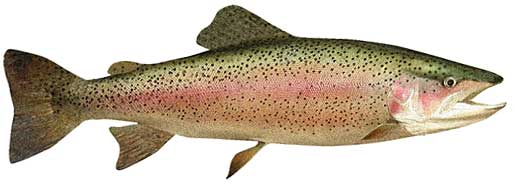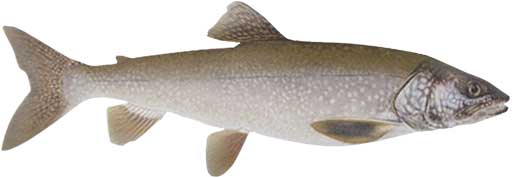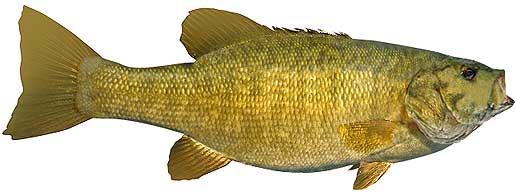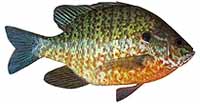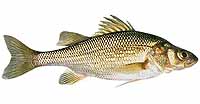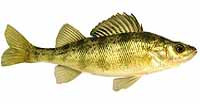Fishing Report For Lake Winnipesaukee, NH
By Rick Seaman
Last updated on .
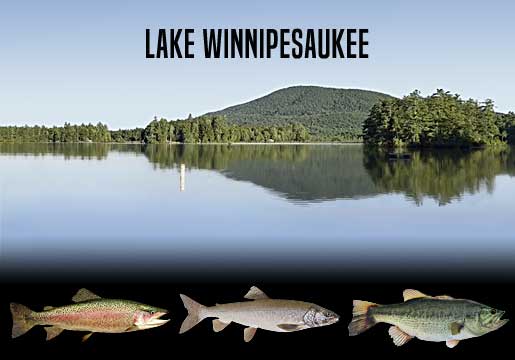
Fishing Reports
Popular Fish Species Lake Winnipesaukee, NH
Rainbow Trout
Current Report: Fair To Good
Stocked rainbow trout populations are maintained to offer a rainbow fishery for anglers of all skill levels. These tasty trout can be caught on bait and small lures, year round.
FALL. Cooling water temperatures in the shallows, are driving rainbow trout into deeper water. Anglers are now catching them 15 to 30 feet deep on rocky banks, wind-blown points, rocky structure, humps, and anywhere baitfish are gathering. Deep drop-offs around the Moultonborough Bay inlet, Pumpkin Point, Paugus Bay and Meredith Bay are great spots for rainbows in Fall. Now that they had a full summer to grow, there are some nice size rainbow to be caught. Small spinners, spoons, jigs, miniature crankbaits and swimbaits are good choices, as are salmon eggs and prepared baits. Later in Autumn, they move into 25 to 40 feet of water.
WINTER. When Winter sets in jigging spoons, and jigs tipped with bait, are catching nice limits of rainbows out of 10 to 25 feet of water. These baits work well around the old river channels and the deeper humps and cuts. Ice fishing, when feasible, can be quite good in the same areas. After ice out, trolling with leaded line or downriggers, or vertical jigging with spoons and jigs, are the best approach during the cold-water season. Slowly worked offerings are more likely to attract bites in this cold water.
SPRING. As water begins to warm in early Spring, rainbow trout move from their late winter holding areas to shallow, warmer water 6 to 20 feet deep. Typical Spring holding areas include points in Alton Bay, shoals along Meredith Bay, and flats in the Wolfeboro area. A good number of rainbows are typically caught from mid morning to late afternoon, during the warmest water of the day. Shallow flats and rocky structure are quick to warm in the afternoon sun. A wide variety of small spinners, spoons and bait are catching most of the fish.
SUMMER. Once Summer is here to stay, the warmer water drives rainbow deeper, 25 to 60 feet deep, occasionally deeper. Trolling with spoons, spinners and crankbaits, using downriggers or leaded line, and drift fishing with bait, are currently the most productive methods. Following drop-offs into deeper water, along structure or creek channels, is a major key to getting bites. Anglers fishing from the bank are using nightcrawlers or Berkley PowerBait, with heavy weights on a Carolina rig, to get baits in deeper water.
Lake Trout
Current Report: Good
During the warmest months of the year, vertical jigging with jigs and spoons, in deep water, is the most popular way to locate lake trout in Lake Winnipesaukee. The same is true for ice fishing. The rest of the year, trolling with spoons, jigs and crankbaits is often the ticket. Drop-offs are a key feature to look for whether these trout are in 20 feet of water ar 75 feet. Lake trout feed on small fish like perch, so lures imitating baitfish, perch or small trout are good choices. Other options include nightcrawlers or Berkeley Power Crawlers, fished on drop-shot rigs. Flashy spoons can be fished at any depth, either jigging, trolling or cast and retrieve. For big lakers, use larger size baits.
FALL. Lake trout are returning to relatively shallow water, as Fall weather cools the lake. They spawn in the Fall, and for a few weeks can typically be found 25 to 60 feet deep on points, flats and humps that have a rocky bottom. Typical Fall holding areas include the southern edges of the Moultonborough Narrows, ledges and drop-offs around Three Mile Island and the Central Basin. Lake trout feed on small fish, so lures imitating baitfish, sunfish, perch or small trout are good choices. Cloudy days, early mornings and early evenings are the best time to catch big lakers. Later in Fall they return to 30 to 80 feet deep, or deeper. Spoons, jigged vertically within the target depth can entice bites. Trolling with spoons, brightly-colored jerkbaits, and spinners with a variety of rigging methods to get these lures to run deep. For big lakers, use larger baits.
WINTER. Favoring water temperatures in the 40's, lake trout find areas to their liking in 50 to 120 feet of water, and tend to stay there throughout the cold months. Learning these areas before the lake ices over can get you into some of the better area for ice fishing. Patient anglers willing to work slowly are catching some nice lake limits through the ice. After ice out, trolling with leaded line or downriggers, or vertical jigging with spoons and jigs, completes the cold-water season in 80 to 100 feet of water, or deeper.
SPRING. Prime laker fishing season is during Spring. Spring weather finds lake trout, along with baitfish, into 25 to 45 feet of water. Early Spring is a prime time to catch big lakers. Lakers are caught in areas of the lake which have deep water next to shallower, feeding spots. Jigs and heavy spoons are catching the majority of these big lakers. Slow trolling with leaded line or downriggers allows small crankbaits and spinners to be worked in deeper water, which also produces some nice fish. Later in Spring they typically drop into 40 to 80 feet of water.
SUMMER. Summer heat drives lake trout deeper, generally below the thermocline in 40 to 120 feet deep. Good areas to explore includes the deepest parts of Moultonborough and Meredith basins. Early and late in the day, lakers may feed shallow. Generally, lake trout prefer to stay deep, below the thermocline, throughout Summer. They look for depth variations like ditches, channels, humps and ledges, but are being caught in the deeper water around this structure. Heavy spoons and jigs, as well as very slow trolling, with leaded line or downriggers, produce many of the lakers being caught during Summer. In late summer concentrate on channel edges, troughs, and main lake humps.
Smallmouth Bass
Current Report: Fair
Lake Winnipesaukee is well-known as a great smallmouth bass fishery, both for size and numbers. The clear water here dictates a bit of stealth, especially when the bass are spawning.
FALL. Fall is in full swing and smallmouth have followed schools of baitfish into coves and bays 8 to 25 feet deep. Now they are migrating back deeper. They thrive in the cold, clean water, which is an ideal environment for them. Known Fall holding areas include the shoals and boulder fields in Meredith Bay, and rocky areas around Pumpkin Point, plus many other rocky points and flats. Locals report that tube jigs are a great choice when the bass are around 15 feet deep. Drop shot rigs with small worms or shad shaped plastics are also popular in 10' water or deeper. Jerkbaits, deep-diving crankbaits, and slow-rolled spinnerbaits, are also successful, when bass are shallow to mid depth. Later in Fall, smallies move to slightly deeper water, around 10 to 25 feet deep. Fishing shallow for smallmouth is often good on cold, windy, cloudy and rainy days.
WINTER. Winter will isolate them around deeper structure, points, flats and creek channels, often suspending in open water above these features. Before, during and after the freeze, they can generally be found from 10 to 30 feet deep. Jigging spoons, tube baits, drop-shot worms, jigs and Ned rigs tend to temp smallmouth in deep water. I like to work these deeper haunts very slowly, as the bass are somewhat sluggish. Here they hold, feeding less frequently, awaiting warmer water to return in Spring.
SPRING. After ice out, when water temperatures rise into the 50's, smallmouth move from deep wintering spots to shallower water, just outside spawning areas. Locals report jerkbaits are a go-to bait in Spring, and will catch smallies pretty much anytime they are shallow. They feed heavily in 4 to 15 feet of water at this time, and are typically caught on jerkbaits, crankbaits, tube baits, Ned rigs, and crayfish imitating plastics. Once water warms into the high 50's, they move into shallower water, and create nests in gravel or sand areas, then lay their eggs. Females then move to deeper water and males remain to guard the eggs, and then the fry. After a couple weeks, the males also move into 15 to 20 feet deep, and feed aggressively. Crankbaits, tube baits, Ned rigs, plastic worms, spoons and swimbaits are catching smallies during this period.
SUMMER. Smallmouth bass are currently feeding shallow early and late in the day in 10 to 15 feet of water. They are being caught on topwater, crankbaits, swimbaits, Ned rigs and tube baits. Smallmouth bass here feed on crawfish, gizzard shad, and small sunfish. They prefer rocky or gravel bottom areas, as this is where crayfish live. During the hotter parts of the day, they are being caught on points, humps, and ledges around 20 to 35 feet deep. Often these deeper fish tend to school, so finding them can deliver some fast action. In hot months, look for smallies around steep rock drop-offs, humps and islands, deep weedline edges, and along the shoulders of creek channels.
Fishing Video
Fish species to fish for...
Guide to fishing for largemouth bass, smallmouth bass, rainbow trout, brook trout, lake trout, pumpkinseed sunfish, redbreast sunfish, white perch, yellow perch, landlocked salmon and chain pickerel at Lake Winnipesaukee in New Hampshire.
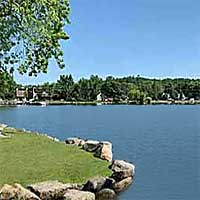 Lake Winnipesaukee is a 44,000-acre lake with nearly 250 miles of shoreline. The lake is populated with bass, trout, sunfish, perch, salmon and pickerel. For those seeking to fish from the bank, there are multiple areas with public access. During winter, once the ice is safe, the lake is very popular for ice fishing.
Lake Winnipesaukee is a 44,000-acre lake with nearly 250 miles of shoreline. The lake is populated with bass, trout, sunfish, perch, salmon and pickerel. For those seeking to fish from the bank, there are multiple areas with public access. During winter, once the ice is safe, the lake is very popular for ice fishing.
Primary fish species to catch
Click images for fishing tips and details about each species.
Today's Weather & Forecast
Fishing Boat Rentals
Click here for fishing boat rentals.
Public Boat Launch Ramps & Landings
Click here for boat ramps.
Fishing License
Click here for a New Hampshire Fishing License.
Map - Fishing & Access
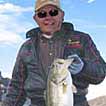 Rick Seaman is a fishing enthusiast with over five decades of fishing experience, a retired tournament fisherman, author of numerous published articles on fishing, and co-author of the book "Bass Fishing - It's not WHAT you throw, It's WHERE you throw it".
Rick Seaman is a fishing enthusiast with over five decades of fishing experience, a retired tournament fisherman, author of numerous published articles on fishing, and co-author of the book "Bass Fishing - It's not WHAT you throw, It's WHERE you throw it".
 Contact Information
Contact Information
Ellacoya State Park
280 Scenic Dr
Gilford, NH 03249
603 293-7821
Fishing lakes in each state
111425
Lake Winnie, New Hampshire Report
NEW HAMPSHIRE


Information about fishing lakes in NH
Fishing for bass, trout, sunfish, perch, salmon and pickerel in east-central New Hampshire.


